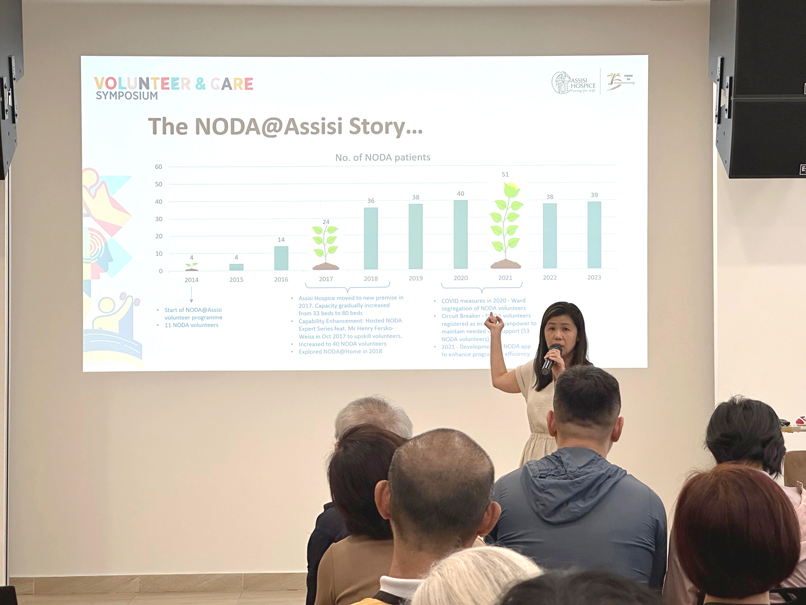Learning from Hospice – Nursing Homes and Social Service Agencies Explore Providing End-of-Life Support for Elderly Patients Without Family Support
published by Lianhe Zaobao on May 27, 2024
Translation of article:
As the local population ages and family sizes shrink, it is anticipated that more patients with terminal illnesses will face the end of life alone due to lack of family support. To care for these patients, nursing homes and social service agencies, originally not involved in end-of-life care, have started learning from the hospice to explore providing end-of-life support for elderly patients without support.
One of the programmes these nursing homes and social service agencies are interested in referencing is the “No One Dies Alone” (NODA) programme provided by Assisi Hospice.
In conjunction with its 55th anniversary, Assisi Hospice hosted a series of seminars on palliative care at the end of March. In one of these sessions focused on NODA, approximately 80 employees and volunteers from around 30 organisations attended to learn about how NODA recruits, selects, and trains volunteers. These organisations mostly include nursing homes, community hospitals, as well as social service agencies and churches.
Juliet Ng, Head of Communications and Community Engagement at Assisi Hospice, revealed during an interview with Lianhe Zaobao that in recent years, they have received significantly more enquiries from these organisations about implementing NODA.
“With the accelerated aging population, some institutions that hadn’t previously considered providing such services are now exploring this possibility,” she said.
Building Friendships with Patients; Rotating Shifts to Accompany Them in Their Final 48 Hours
Assisi Hospice introduced the NODA programme in 2014, which consists of two stages: “befriending” and “vigil”. Trained volunteers typically start building friendships with patients shortly after their admission. When doctors assess that a patient has approximately 48 hours left, volunteers begin rotating shifts to keep vigil at the patient’s bedside until their last breath.
Over the past decade, the number of lonely patients cared for under this programme has been increasing, from four in 2014 to between 36 to 40 annually over the past five to six years. During the COVID-19 pandemic in 2021, stricter visitation restrictions led to a surge in demand, with the number of patients peaking at 51.
Juliet Ng pointed out that initially, the NODA programme catered to patients who were single and lacked family support or had broken relationships with their families. “Today, many patients still have one or two relatives they are in contact with, but these relatives are elderly or have other family responsibilities. Some patients have a child who is abroad… for whatever reason, as long as the patient may be alone at the end of life, we will offer them the NODA programme.”
Liu Ruiwen, Manager, Community Partnerships of Lentor Health Nursing Home, participated in the workshops to better understand the NODA programme. She noted that while cases of residents dying alone in Lentor Health Nursing Homes are currently rare, it cannot be ruled out that such cases may increase in the future.
There are three nursing homes under Lentor Health, two of which began services last year. “With the gradual increase in number of residents, there may be more people in need of similar end-of-life companion services,” Liu predicted. Nursing homes have also observed a trend of declining visitors.
“We want to delve deeper into the NODA programme. We do not rule out the possibility of establishing a similar project, but there are several factors to consider, including whether we can effectively recruit, train, and manage volunteers, whether we can provide appropriate support to volunteers, and whether we can meet the needs of terminally ill patients from different cultural and religious backgrounds.”
She noted that the organisation may consider starting with befriending services. “Befriending services can allow volunteers to establish deeper connections with residents who need end-of-life companionship, which may improve the quality of life for them. After that, we may expand services to end-of-life vigil and companionship.”
Fei Yue Community Services also intends to further understand the field of end-of-life care. Zheng Cai, Senior Assistant Project Executive at the social service agency, attended the seminar at Assisi Hospice. He pointed out, “Today, more elderly people choose to live independently and not rely on others. Fei Yue wants to learn about end-of-life care because we may consider launching community projects to assist elderly individuals with severe illnesses who need end-of-life care, including those without family support.”
Click Here for the original article.
Hospice Plans to Expand Volunteer Team to Meet Increasing Demand for End-of-Life Companionship
Translation of article:
Local hospices providing end-of-life companionship for lonely, terminally ill patients intend to expand their volunteer teams to meet growing demands.
Assisi Hospice’s “No One Dies Alone” (NODA) program currently has 56 volunteers, and the hospice aims to increase this number to 65 by 2025.
At Assisi Hospice, the average length of stay for terminally ill patients is approximately 20 days. Volunteers begin accompanying patients shortly after admission under the NODA programme. When patients enter their final stages of life, volunteers receive notifications via a mobile app and coordinate to start three-hour shifts or six-hour night shifts to keep vigil at the patient’s bedside.
Volunteers are required to regularly serve at the hospice, assist nurses in patient care, and build friendships with patients. Hence, by the time the vigil is called, volunteers often become the patient’s “surrogate family” rather than strangers.
As patients in the hospice come from diverse backgrounds, volunteers are expected to prioritise the welfare of the patients, and are not allowed to evangelise or promote other agendas. They should also be able to work in a team and possess emotion coping skills. The hospice provides emotional support and counselling for volunteers.
Dover Park Hospice, another end-of-life care organisation, has been providing the vigil programme since 2014 for patients without family support. From 2017 to 2019, they have vigiled for over 10 patients annually. However, the service was suspended due to the COVID-19 pandemic and resumed in 2022, currently with 23 volunteers. Anticipating increased demand for vigil services, Dover Park Hospice aims to recruit more volunteers to better serve patients in need.
Since 2019, the Institute of Mental Health has also launched its “No One Dies Alone” programme under the initiative of volunteers, providing companionship and vigil services for long-term hospitalised patients with terminal illnesses, and have no family support. From 2019 to 2023, they have cared for a total of 11 patients.
When approached for comment, the Institute of Mental Health indicated that their project currently involves eight volunteers, and is sufficient to meet current demands. While there are no specific plans to expand the NODA volunteer team at present, the group holds annual briefings to recruit more existing volunteers to join NODA.
Click Here for the original article.

